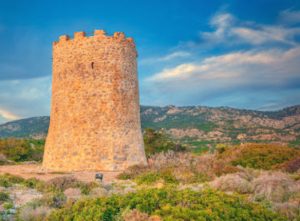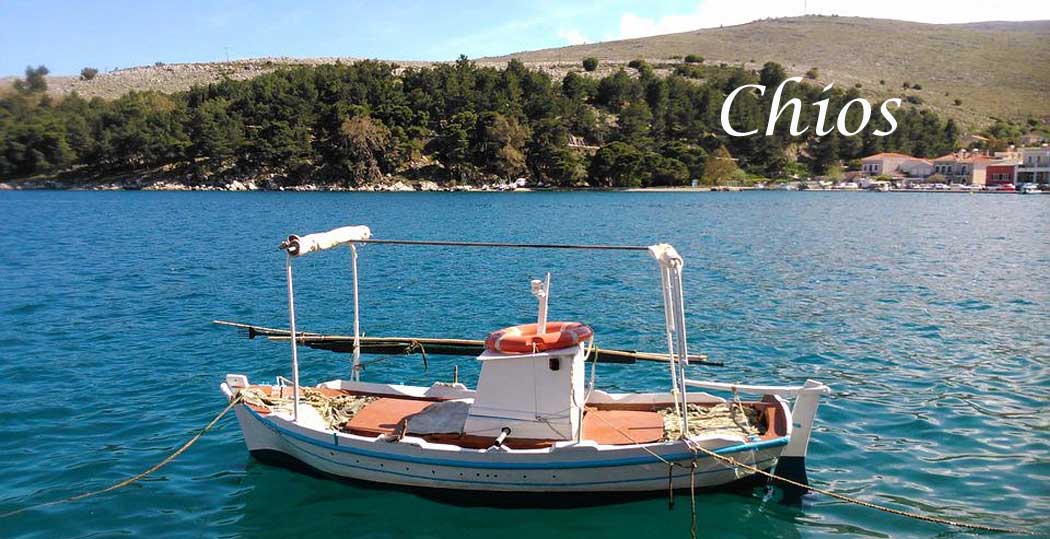Vigles, the medieval watchtowers of Chios

They are a coastal network of observation and transmission of messages and were built during the Genoese period, within the framework of the defensive fortification of Chios during the period between 1346 and 1566, when the island was occupied by the Genoese (or, otherwise, Genoese). The Medieval Watchtowers of Chios continued to function until the middle of the 18th century. at least, so the piracy problem starts to disappear.
Constructions of this kind were called phryktoria by the ancient Greeks. The Romans used the term vigilarium (which included watchtowers of all kinds). The Byzantines called them kaminoviglia. Other names such as towers, turrets, lighthouses, cantilevers, watchtowers were also used. The Italian word for vigilance was vigilanza and for vigilatore vigilatore. The word “Vigla” has a Latin root. It comes from vigil or vigilia which means lookout, sentry, observatory.
Its original meaning was “vigilance”. The word passed into Greek rather through Byzantium than through the Italians, who, however, are responsible for the construction explosion of vigils in the Greek area during the late Middle Ages. During the Genoese rule, Chios did not have a large military force, but the defense of the island was organized by the creation of castles and fortified settlements, as well as a network of coastal vigils that was, by far, the most extensive in Greece. It is believed that during the period of full use and operation of the defense network, there were around 50 Watchtowers in Chios. Today, at most 35 are identified along with those of which only traces are preserved. Of these, 24 are declared as preserved monuments.
Location
The dispersion of Watchtowers is much denser in the south and west of the island. One reason for this is that the northern part of Chios is mountainous with high peaks. Thus, the morphology of the terrain offers natural protection and the possibility of high observation without the need for the construction of many observatories. In the southern part of the island the coasts are more accessible. In addition, the fertile plain and especially the valuable mastic trees provided wealth and prosperity there, which was a particularly attractive prey for pirates.
Therefore the need for defense constructions was more pressing there, plus the fact that there were more resources available for this purpose. In the edition of Philippos Argentis “Chios despite the Geographers and travelers”, the following verse from the work “Voyages de M. de Thevenot tant en Europe qu’ en Asie et en Afrique” by Jean de Thevenot (Paris 1689) is cited: Because the plains of Chios were full of mastic trees, there had to be people who guarded it and collected it in its season, for this reason there were small villages on the plain with thirty, fifty, a hundred souls each.
But because they were being harassed by the Turks of the East, which is about 18 miles distant, who were plundering people and things, all these villages decided to unite three or four together and build castles or towers, in order to secure themselves against pirates.
In order to protect the trees and the villages, they built towers around the island at a distance of three or four miles from each other. In each neighboring village, two men were sent there to keep watch and when they saw boats, ships or galleys, they alerted them to retreat or retreat.
The choice of the location in which the Watchtower was built was made with the aim of the best possible control of the sea, and based on the depth of the horizon, the existence of passages, the ease of landing and the possibility of communication with other parts of the island.
Particular attention was needed in the places offered for the docking of ships. The position and distance between two beacons depends on local conditions, the shape of the mirrored coasts, the morphology of the terrain, but also the maximum distance at which there can be satisfactory visibility under adverse weather conditions. In the Watchtowers we know today, the distance varies from 1.6 km to 3.8 km. Jean de Thevenot in 1656 mentions a distance of three or four miles, while the historian Hieronymos Justinianis, in 1586, considers that the appropriate distance between two Watchtowers is a mile.
Construction
In terms of their construction, the Watchtowers were largely standardized. A typical Vigla in Chios is cylindrical, with an average trunk diameter of 7.50m. and a total height of about 12 meters. It consists of a 2/3 butted trunk with a conical, usually, base (scarp), a room at a height of about 8 m from the ground that houses is formed by a semi-cylindrical dome, on which rests the roof with the ramparts. A feature in many Watchtowers is the conical widening from the lower part of the trunk towards the base, called a scarpa. This configuration strengthened the strength of the structure, both statically and in cannonades.
The scarpa also prevented attackers from getting too close to the vigla wall, out of sight of the viglators. This peculiarity exists only in the Watchtowers of Chios and not in all of them. The stonework is made of local stones, lightly carved on their outer surface and connected with kurasan, i.e. lime mixed with ground tile and sand. At the base the wall has a thickness of up to 2m, while at the trunk the average thickness decreases to 1m. The interior of the Watchtower was plastered from the base up to two thirds of the total height. The room formed at the top of the vigla (at a level of about 8 m.) is housed with a low dome. A hatch at the end of the dome allowed communication between the interior and the roof of the vigla where the ramparts are located.
Watchtowers had no entrance and no door in the lower part, but most had a rudimentary door in the upper room. Entry was by windlass, rope or portable wooden ladder. The vigilators entered either through the door of the room or, more commonly, went straight up to the ramparts and from there descended further down. The door, which was never on the sea side, was well barred, while in most cases there was a catechistra (defensive structure into which hot liquids were poured) above it.
There were fire pits in other places, around the perimeter. Small trapezoidal windows were opened in the vigilator’s room that ended in narrow holes, while in some cases additional war holes were opened. Around the viglas there were also auxiliary small buildings for various uses: for the animals, for storing wood, for food, and even for the accommodation of the viglators, since the vigla itself did not have many comforts for living, food preparation, personal hygiene etc.
Defensive role
The Watchtowers were primarily used as lookouts, but their role was also defensive. They also had a deterrent role due to the image of readiness they gave for the island. When the viglator saw an enemy ship, he alerted the other viglas and the villages. Even neighboring islands. Distress signals were given by smoke during the day and fire at night. For this purpose they used either flammable wood, dry grasses, bushes, reeds, etc. for a lively fire at night or wet hay and cattle dung (swoonies) for thick smoke during the day.
The coded messages warned of the upcoming landing point and the number of boats, so that a military force could be sent to repel the raider, and the villagers could take shelter inside the villages which, especially in the area of Mastichohoria, were fortified. In any case, the message had to reach the Town of Chios, to the Castle.
The fire was supposed to be lit on top of the vigla, but it is extremely likely that it was most often lit outside the vigla when the danger was not immediate and there were no visibility problems. Also, many times the distress signal was transmitted personally by the vigilators themselves who rushed to the nearest village (on horseback or on foot) to give notice when they did not want to give a target (as a kind of silent alarm). The vigils were usually manned by two men, the viglators. At all times one of the two vigilators was on watch duty. Among the duties of the viglator was the maintenance of the Watchtower and any urgent repairs.
The Watchtower men were carefully selected by the local population and their appointment was official. The position required responsibility and skills. Each vigilator took turns going every other Sunday to his village to visit his family. He was due back the same day with the week’s supplies. The expenses of the vigla and the crew were covered by the neighboring villages. Often, after the danger was signaled, the Watchtowermen would abandon their position. They did not do this to save themselves, as the pirates had no reason to waste time and energy to besiege Watchtower.
Sometimes they left to deliver the danger message in person, but the main reason was to take part in the defense of the settlements as Watchtowermen were among the few experienced warriors available. The Watchtowermen were lightly armed for defense and dealt with attackers by throwing javelins and stones. The catacombs were an effective means of defense. Later their armaments evolved to include firearms, perhaps a small cannon, and various types of rifles, depending on the era: espigards, arquebuses, muskets etc..
